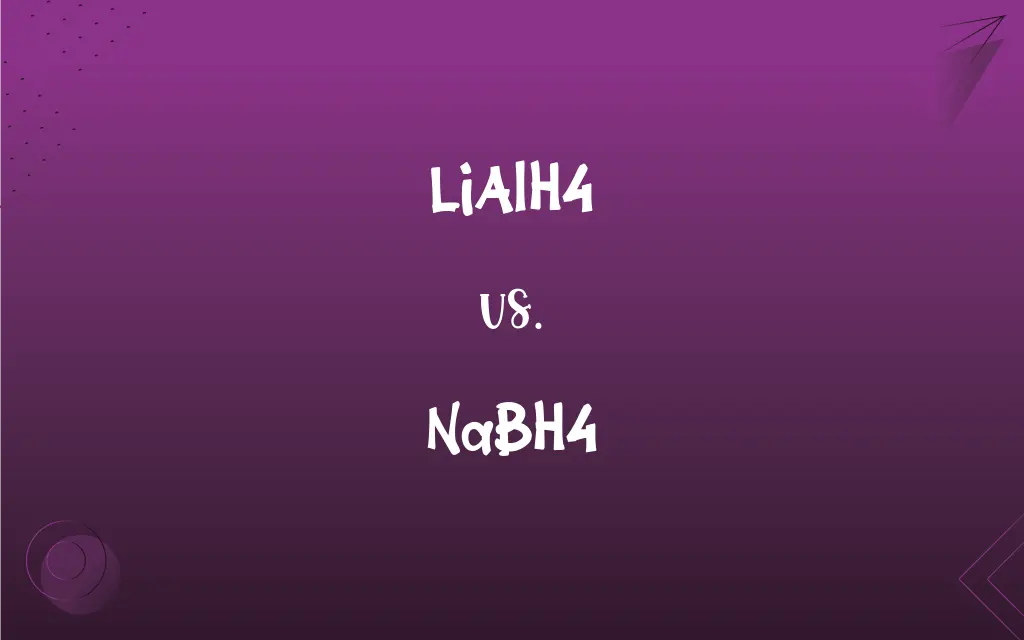LiAlH4 vs. NaBH4: What's the Difference?
Edited by Aimie Carlson || By Janet White || Published on March 1, 2024
LiAlH4 (lithium aluminium hydride) is a strong reducing agent, while NaBH4 (sodium borohydride) is milder and more selective in reductions.

Key Differences
LiAlH4 is a potent reducing agent, capable of reducing a wide range of organic compounds, including carboxylic acids, esters, and amides. NaBH4 is less reactive, primarily reducing aldehydes and ketones, and is less effective with esters and amides.
LiAlH4 is used in complex organic syntheses for reducing many functional groups. NaBH4, due to its selectivity, is preferred for reducing specific groups without affecting others in sensitive synthesis.
LiAlH4 is more reactive and sensitive to moisture, requiring careful handling under inert atmosphere. NaBH4 is more stable and can be handled in less stringent conditions, making it safer for routine laboratory use.
LiAlH4 is generally used in dry ether solvents and reacts vigorously with water. NaBH4 is soluble in water and alcohols, offering more versatile reaction conditions.
LiAlH4, being more reactive and hazardous, is generally more expensive and less readily available than NaBH4, which is cheaper and more commonly used in laboratories.
ADVERTISEMENT
Comparison Chart
Chemical Reactivity
Strong reducing agent
Milder, more selective reducing agent
Usage in Synthesis
Reduces a wide range of functional groups
Preferred for specific group reductions
Handling and Safety
Sensitive to moisture, requires inert atmosphere
More stable, safer for routine use
Solubility and Reaction Conditions
Used in dry ether, reacts with water
Soluble in water and alcohols, versatile
Cost and Availability
More expensive, less available
Cheaper, more commonly available
ADVERTISEMENT
LiAlH4 and NaBH4 Definitions
LiAlH4
LiAlH4 is a strong reducing agent in organic chemistry.
LiAlH4 was used to reduce the ester to an alcohol in the reaction.
NaBH4
NaBH4 is often used for selective reduction reactions.
To avoid reducing other groups, NaBH4 was chosen for its selectivity.
LiAlH4
LiAlH4 is less common in routine laboratory use due to its reactivity.
For safety reasons, LiAlH4 is not used as frequently as other reducing agents in the lab.
NaBH4
NaBH4 is stable in air and water, making it safer to handle.
The experiment used NaBH4 due to its ease of handling and stability.
LiAlH4
LiAlH4 is sensitive to moisture and reacts vigorously with water.
The LiAlH4 must be handled under dry conditions to prevent a violent reaction.
NaBH4
NaBH4 is soluble in water and alcohols, offering versatile uses.
The reaction was carried out in an aqueous solution using NaBH4.
LiAlH4
LiAlH4 is employed in complex organic syntheses.
The complex molecule was synthesized using LiAlH4 to reduce multiple functional groups.
NaBH4
NaBH4 is a milder reducing agent, often used in organic chemistry.
NaBH4 was used to selectively reduce the ketone in the compound.
LiAlH4
LiAlH4 is used for reducing a broad spectrum of organic compounds.
To synthesize the amine, LiAlH4 was chosen for its ability to reduce the amide.
NaBH4
NaBH4 is more commonly used in laboratories due to its safety and availability.
NaBH4 is a staple in organic chemistry labs for routine reductions.
FAQs
How reactive is LiAlH4?
LiAlH4 is highly reactive, capable of reducing a wide range of organic functional groups.
What is LiAlH4?
LiAlH4, or lithium aluminium hydride, is a powerful reducing agent used in organic chemistry.
Can LiAlH4 reduce carboxylic acids?
Yes, LiAlH4 can reduce carboxylic acids to alcohols.
What is NaBH4?
NaBH4, or sodium borohydride, is a milder, selective reducing agent in organic synthesis.
Is LiAlH4 soluble in water?
No, LiAlH4 reacts violently with water and is used in dry ether solvents.
Is NaBH4 safer to use than LiAlH4?
Yes, NaBH4 is safer due to its stability in air and water.
Is NaBH4 used for reducing esters?
NaBH4 is generally not effective for reducing esters.
What precautions are needed when using LiAlH4?
LiAlH4 requires an inert atmosphere and dry conditions due to its sensitivity to moisture.
Is NaBH4 a good choice for large scale reductions?
NaBH4 is preferred for large scale reductions due to its safety and cost-effectiveness.
Can NaBH4 reduce ketones?
Yes, NaBH4 is commonly used to reduce ketones to secondary alcohols.
What solvents are suitable for NaBH4 reactions?
NaBH4 can be used in water and alcohol solvents.
Why is LiAlH4 not commonly used in routine labs?
Due to its high reactivity and stringent handling requirements, LiAlH4 is less common in routine labs.
How expensive is LiAlH4 compared to NaBH4?
LiAlH4 is generally more expensive due to its reactivity and handling requirements.
Can LiAlH4 be handled in open air?
No, LiAlH4 should not be handled in open air as it is moisture sensitive.
What are the storage requirements for LiAlH4?
LiAlH4 should be stored under dry, inert conditions to prevent decomposition.
Is NaBH4 reactive with water?
NaBH4 is stable in water, making it suitable for aqueous reactions.
Does NaBH4 have limitations in reduction?
NaBH4 is less effective in reducing esters, amides, and carboxylic acids.
Can NaBH4 reduce aldehydes?
Yes, NaBH4 is effective in reducing aldehydes to primary alcohols.
Can NaBH4 be used in complex syntheses?
NaBH4 is used in complex syntheses when selective reduction is needed.
What type of compounds can LiAlH4 reduce?
LiAlH4 can reduce compounds like esters, amides, and aldehydes.
About Author
Written by
Janet WhiteJanet White has been an esteemed writer and blogger for Difference Wiki. Holding a Master's degree in Science and Medical Journalism from the prestigious Boston University, she has consistently demonstrated her expertise and passion for her field. When she's not immersed in her work, Janet relishes her time exercising, delving into a good book, and cherishing moments with friends and family.
Edited by
Aimie CarlsonAimie Carlson, holding a master's degree in English literature, is a fervent English language enthusiast. She lends her writing talents to Difference Wiki, a prominent website that specializes in comparisons, offering readers insightful analyses that both captivate and inform.






































































